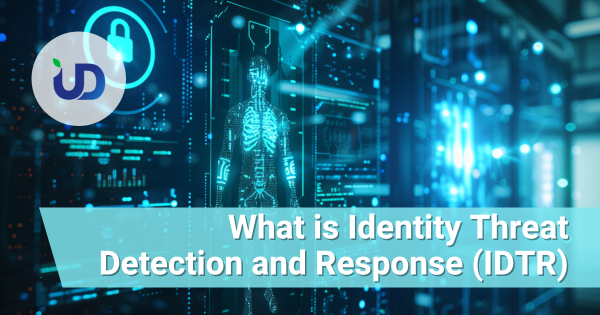Identity Threat Detection and Response (ITDR): The Essential Guide for Modern Cybersecurity
Identity is the new perimeter — and for most organisations, it’s also the weakest link. As attackers shift from exploiting traditional infrastructure vulnerabilities to targeting identities, credentials, and access paths, security teams need a dedicated strategy to protect this rapidly growing attack surface. This is where Identity Threat Detection and Response (ITDR) steps in.
In this guide, we break down what ITDR really is, why it matters, and how businesses can build a stronger defence against identity-based cyberattacks.
What Is Identity Threat Detection and Response (ITDR)?
Identity Threat Detection and Response (ITDR) is a cybersecurity capability that focuses on detecting, analysing, and responding to threats involving digital identities — including human accounts, service accounts, privileged access, and machine identities.
Unlike traditional security tools that focus on endpoints or network traffic, ITDR zeroes in on identity behaviour, authentication patterns, access misuse, and privilege escalation attempts.
It helps security teams identify when an account is being abused, when authentication flows look suspicious, and when attackers attempt to move laterally using stolen credentials.
ITDR combines technologies such as identity analytics, behavioural monitoring, deception techniques, and automated remediation to stop attackers even when they bypass other security controls.
Why ITDR Has Become a Critical Layer of Cyber Defence
Today’s cyberattacks rarely start with malware — they start with identity compromise.
Phishing, MFA fatigue, credential stuffing, cloud misconfigurations, and leaked API keys have made it easy for attackers to impersonate legitimate users.
Once an identity is compromised, attackers can stealthily escalate privileges, access sensitive systems, and deploy ransomware without triggering traditional alerts.
This shift in attacker behaviour makes ITDR essential.
ITDR delivers deeper visibility into identity-based risks, monitors privilege misuse, and detects malicious behaviour that traditional SIEM, EDR, or IAM tools often miss.
How ITDR Works: Key Components Explained
ITDR works by combining detection, analytics, visibility, and automated response.
Here are the core pillars that form an effective ITDR strategy:
1. Identity Visibility and Baseline Behaviour
ITDR tools map all identities in your environment — users, service accounts, machine identities, cloud roles — and establish what “normal” behaviour looks like.
This creates a behavioural baseline that helps identify anomalies quickly, such as unusual login times, impossible travel, unexpected API calls, or abnormal privilege usage.
2. Continuous Monitoring of Authentication & Access Activities
Instead of relying solely on logs, ITDR solutions monitor authentication flows in real time.
This helps detect suspicious login attempts, MFA bypass patterns, and lateral movement carried out using compromised credentials.
3. Identity Threat Analytics
Modern ITDR platforms use machine learning and analytics to correlate user behaviour, privilege changes, access patterns, and environmental risk factors.
When combined, these insights allow ITDR to detect attacks like credential stuffing, insider threats, and automated identity abuse.
4. Automated Response and Containment
When a high-risk identity threat is detected, ITDR can trigger automated actions such as:
Disabling accounts
Resetting credentials
Isolating endpoints
Revoking tokens or active sessions
Enforcing step-up authentication
This reduces the time attackers spend inside systems and limits potential damage.
Common Identity-Based Attacks ITDR Helps Defend Against
Identity threats come in many forms — from weak passwords to sophisticated cloud privilege escalation.
ITDR is designed to protect organisations against attacks such as:
Credential Theft and Account Takeover
Attackers frequently steal passwords through phishing, keyloggers, dark web leaks, or malware.
ITDR detects when an account starts behaving abnormally after being compromised.
Privilege Escalation and Role Misuse
Even low-level accounts can be used to gain access to higher privileges.
ITDR monitors changes in role assignments, privilege elevation, and sensitive permissions.
Lateral Movement Using Compromised Credentials
Attackers often move sideways across networks using valid accounts instead of malware.
ITDR identifies when identities attempt unusual access paths or jump between systems.
Service Account Abuse
Machine identities often have excessive permissions and no MFA.
ITDR keeps track of anomalous API behaviour, unusual automation tasks, or over-permissioned service accounts.
ITDR vs IAM vs PAM: What’s the Difference?
Many businesses confuse ITDR with Identity and Access Management (IAM) or Privileged Access Management (PAM), but the roles are distinct.
IAM controls who can access what.
PAM controls how privileged users access sensitive systems.
ITDR detects when identity access behaviours become risky or malicious.
IAM and PAM prevent misuse; ITDR identifies and responds to misuse.
Together, they form a complete identity security ecosystem.
How Organisations Can Implement ITDR Effectively
Adopting ITDR is not just a technology upgrade — it’s a change in how organisations think about identity.
To implement ITDR successfully, businesses should:
Start by mapping all identities across cloud and on-prem environments
Monitor authentication events and build behavioural baselines
Integrate ITDR with existing SIEM, EDR, IAM, and MDR tools
Automate high-risk response actions to reduce dwell time
Review and reduce over-permissioned accounts regularly
By embedding ITDR into the security stack, companies can significantly strengthen defences against modern identity-focused attacks.
Conclusion: ITDR Is No Longer Optional
Identity attacks are now the No.1 cause of data breaches globally.
As enterprises move toward cloud-native, hybrid, and remote-work environments, identity has become the primary entry point for cybercriminals.
ITDR provides the missing layer of detection and response needed to protect digital identities across endpoints, networks, and cloud platforms.
For organisations already investing in pentest, SRAA, and MSSP services, adding ITDR creates a stronger, more complete security posture.
ITDR is the future of identity protection — and early adopters will have a clear advantage in stopping identity-driven cyber threats.
🛡️ Ready to Strengthen Your Security?
UD is a trusted Managed Security Service Provider (MSSP)
With 20+ years of experience, delivering solutions to 50,000+ enterprises
Offering Pentest, Vulnerability Scan, SRAA, and a full suite of cybersecurity services to protect modern businesses




